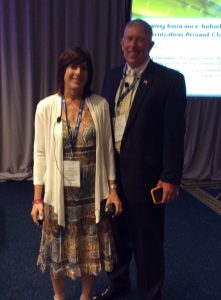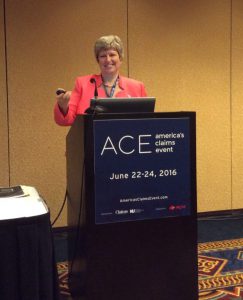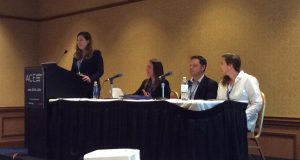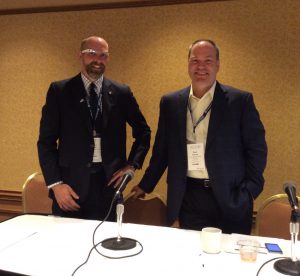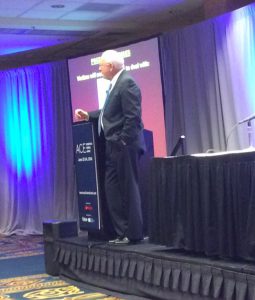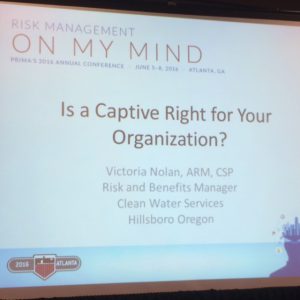Modernizing Claim Payments
At the 2016 ACE Conference, Randi Lichtenstein from BNY Mellon and Don St Jacques from Jopari Solutions discussed opportunities for insurers to increase adoption of electronic payments. Payment Evolution Countries like the UK have payment systems that are advanced beyond ours and they have not been paper check based for years. Paper checks are very inefficient. The average cost of issuing a check is almost $6. In addition to print and mail costs, checks can get lost and need to be reissued, remain uncashed requiring escheatment, and cause delays getting payments to consumers. There are many growing pressures on what
(Read the full article…)
Prescription Management
At the 2016 ACE Conference, Caryn Siebert with Knight Insurance Group presented a session discussing the challenges and solutions involved in prescription management. In 2014, opioid overdoses killed over 28,000 patients. From 1999 – 2013, the number of opioid prescriptions quadrupled. Earlier this year, President Obama called for additional federal government funding to prevent opioid abuse. Opioid treatment should be limited to 3-7 days during the acute phase of the injury. Beyond that things like ibuprofen or other over-the-counter drugs should be sufficient. Unfortunately, too often opioids are used as the first and only treatment for pain. For any pain
(Read the full article…)
Vendor Relationships and Quality Control
At the 2016 ACE conference, a panel discussed how good vendor relationships can help you achieve your company’s mission. The panel was: Jennifer Cooper-Matlack from New Jersey Manufacturers Patricia Walsh from New Jersey Manufacturers George Rosch from CCC Information Services Laura Werner from CCC Information Services Employers, carriers and TPAs partner with vendors to provide services they cannot do in-house. This can often be a roller-coaster ride with peaks and valleys in the relationship. There are five important steps in the vendor management process: Step One – Set expectations and outcome confirmation You want to clearly identify and define customer
(Read the full article…)
Wearable Technology’s Impact On Claims Management
At the 2016 ACE Conference, Brad Koland, Director of Risk and Insurance Management with Land O’Lakes and Jarrod Magan, VP Client Technology Services with Sedgwick discussed the increasing role that wearable technology is playing in claims management. We are not far away from the day when an individual’s wearable device can upload data directly to a person’s health record. This could monitor things like insulin levels for diabetics, blood pressure and heart rates, sleep patterns, and compliance with taking prescribed medications. There are even wearables that can monitor sun exposure and recommend reapplying sunscreen. By 2020 more than 75 million
(Read the full article…)
Kidnap, Ransom & Extortion
At the 2016 ACE Conference, Wesley Odem Jr from The Ackerman Group LLC presented a session talking about the evolving risk of kidnap, ransom and extortion of company executives. For a classical kidnapping there are several hallmarks: The targets are always pre-selected. This is not usually tourists because of the time it takes to set up something like this. Kidnappers are normally motivated by money but it can be ideological. Ransom payments can be considerable. Surveillance precedes the abduction. It usually happens near home or the work place. Captivity lasts days, weeks or even months. The worst country for kidnappings
(Read the full article…)
America’s Claims Event
On June 22-24, 2016, Conference Chronicles will be blogging from America’s Claims Event (ACE) in Minneapolis, MN For two decades, ACE has been a leader in bringing together the decision makers in the areas of property and casualty and auto insurance, as well as risk management and workers’ comp. The conference offers tracks in risk management, workers’ comp, auto, property & casualty, legal, and technology. You can learn more about the ACE Conference here
Understanding the Verdict Sheet
At the 2016 ACE conference, a panel discussed the importance of the verdict sheet in civil litigation. The panel was: Darryl Wilson -Anderson, Crawley & Burke, Plc Alan Yacoubian – Johnson, Yacoubian & Paysse Howard Shafer – Shafer Glazer, LLP Rocky Feemster – Touchstone Bernays Broderick Young – Arnett, Draper & Hagood Evan Jones – Landrum & Shouse, LLP There are significant differences between the states when it comes to how they view issues like comparative negligence, joint and several liability, and contributory negligence. It is important to fully understand these differences so that the verdict sheet can focus on
(Read the full article…)
WCIRB Research Forum
At the 2016 WCIRB Conference a panel discussed some of the geographic variations in costs seen in the California workers’ compensation system. This was a compendium of a variety studies done by WCIRB and CWCI. California has significant differences in wage levels and occupations by geographic area in the state. There are also variations in the unemployment rate as areas outside the LA Basin and Bay Area have significantly lower unemployment rates. Outside of the major cities, the main industry is agriculture. Claim costs in the LA Basin are significantly higher than the rest of the state. This was illustrated
(Read the full article…)
State of the System: WCIRB perspective
At the WCIRB California Annual Conference, Chief Actuary Dave Bellusci presented their update on the California workers’ compensation system. 2015 was the sixth consecutive year of $1 billion premium growth in California. This is expected to flatten or decrease slightly in 2016 because of lower rates. In 2015 California accounted for 29% of the total countrywide workers’ compensation premiums. The premium growth the last two years has been mostly due to payroll growth. In 2012 and 2013 most of the premium growth was due to rate increases. The top 5 carriers in California write 42% of the premiums. 70% is
(Read the full article…)
Is a Captive Right For Your Organization?
Utilizing a captive is often considered the highest form of self-insurance, but is it right for your entity? There are many reasons for a public entity to consider forming a captive, and just as many reasons not to form one. This session walked through the evaluation process and provided practical knowledge on how to analyze whether forming a captive is a good fit. This PRIMA 2016 session was presented by Victoria Nolan, Risk and Benefits Manager, Clean Water Services. A captive is a formalized self‐insurance program that operates as an insurance company to its parent, collecting premiums and paying claims,
(Read the full article…)

